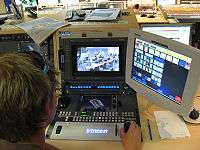Vinten
 | |
| Founded | 1910 |
|---|---|
| Founder | William Vinten |
| Headquarters |
Bury St Edmunds, Suffolk U.K. |
| Products | Camera Supports: Pan & Tilt Heads, Tripods and Pedestals |
| Website | vinten.com |
Vinten is a manufacturer of camera supports founded in 1910 and based in Bury St Edmunds, Suffolk.
History
Vinten, then trading as 'W. Vinten Cinematograph Engineers', was formally founded by William Vinten in 1910 and was originally based at 89-91 Wardour Street, London. The company began in 1909 by manufacturing Kinemacolor projectors for Charles Urban.[1]
In 1914, the company workshops were taken over by the government and Vinten were invited by Sopwith at Kingston upon Thames to work alongside them in their aeroplane factory. This led in 1915 to an invitation by the Royal Flying Corps for William Vinten to design and build a special cine-camera for use in aircraft. Vinten developed the Model B - the first cine-camera that could be operated while hung over the side of an aircraft and as a result began to work in close co-operation with both the military and the film industry.
In 1928 Vinten expanded and moved to Cricklewood, North London, mainly supplying the film industry by creating specialised equipment for companies such as Kodak. By 1937 around three-quarters of all films shown in Britain were processed using equipment developed by Vinten. The company also had a strong presence in creating both sound and production equipment.
The Second World War created an increased requirement for reconnaissance cameras and military contracts secured world market presence for reconnaissance work.
In the late 1940s, the broadcast market began to flourish and Vinten developed the first telerecording camera. As a result the British Broadcasting Corporation became increasingly involved with Vinten. The BBC became the world benchmark for whom Vinten adapted many of their original film camera supports creating equipment more suitable for television cameras.[2]
In 1964 Vinten moved to Bury St Edmunds in Suffolk. In 1972, Vinten was floated on the London Stock Exchange.

In the early 1980s Vinten began to develop remote control TV systems early in conjunction with the BBC for use in their main N1, N2 and N3 news studios. Shortly after this a second venture was undertaken with the Saskatchewan Legislature, using the system to televise State governmental proceedings.
In 1984 the company changed its name to Vinten Group plc.
In 1988 Vinten split into two separate entities. W Vinten Ltd (now Thales Optronics Ltd) focused solely on reconnaissance equipment and moved into new premises. Vinten Broadcast Ltd remained on the same site, concentrating on broadcast mounting equipment solutions.
From 1989 Vinten Group began a series of acquisitions: Manfrotto Group (1989), Bexel (1991), Gitzo (1992), Bogen Imaging (1993), TSM Inc [known for AutoCam product range](1993), Sachtler (1995).[3] Vinten Group plc changed its name to Vitec Group plc in 1995 but the Vinten name continued as Vinten Broadcast Ltd continued to trade as part of the group.
Following the acquisition of Radamec in 2003 a new brand Vinten Radamec was created to take over the manufacture of robotic camera support products.
Vinten continues to be a leading manufacturer of lighweight, television studio and outside broadcast camera supports such as tripods, pedestals and pan and tilt heads.[4]

Notable Vinten Products
Vinten HP 419
The Vinten HP 419 'Hydro-Pneumatic'gas-balanced pedestal was launched in the 1950s. The pedestal enabled TV cameramen to track and jib all at the same time without losing sight of the viewfinder. Many thousands of the HP 419 design were sold worldwide. Very few remain in production use, often replaced by the later Vinten Fulmar.
Vinten Mk 3
The Vinten Mk 3 Pan & Tilt head used risers and cams to maintain the centre of gravity. This made the tilting of heavy cameras considerably easier and if correctly mounted a camera could be left at any tilt angle without lock off. The design (by William Vinten's son Bill) was highly innovative for the time.[5]
Vinten OB Dolly
In the late 1950s Vinten's received a request via the BBC from the Queen. She asked for a less intrusive dolly to be used at Sandringham during the filming of the Royal Christmas Message. The Vinten Outside Broadcasting Dolly was designed to fulfill this requirement. The dolly, which ran on solid or pneumatic tyres, was quite narrow so it could be wheeled easily along a narrow passage or through a royal living room.[6]
Vinten Plover
The Vinten Plover was a compact and relatively lightweight nitrogen-balanced studio/OB pedestal using a central three-stage column and three sets of linked wheels which could be either pneumatic or solid. The centre column could be separated from the wheeled base for transportation.
Vinten Fulmar
The Vinten Fulmar was a hugely popular studio pedestal featuring a three-stage column. Renowned for its smooth movement and robust design the Fulmar can still be found in studios worldwide despite being discontinued for many years.
Vinten Vector
Launched on 1993, the Vinten Vector range of pan and tilt heads are used for television studios and outside broadcast television production. The first Vector head, the Vector 70, was famous for its unique pantographic counterbalance mechanism that allowed heavy broadcast cameras to be balanced without the use of interchangeable cams. The Vector 700 and Vector 750, developed from the Vector 70, can be seen in use at nearly all major broadcasting events.
Vinten Vision
The Vinten Vision range of pan & tilt heads are used for lightweight cameras and camcorders. In 1988 the Design Council selected the Vision Range for display in the Design Centre, London, where the products were presented to the Duke of Edinburgh.
Vinten Quattro
The Vinten Quattro pedestal range was introduced in 1996 and features a four-stage column design that provides an on-shot stroke of 100 cm/39.4". The pedestal is now available in three versions: studio, outside broadcast and compact studio.[7]
Vinten Vision blueBridge
By raising the centre of gravity of the camera sitting on a Vision blue head, the Vinten Vision blueBridge deliver perfect balance to lightweight DSLRs from just 1.5 kg/3.3lbs. The Vision blueBridge won the DVuser award at NAB2013.
Vinten Family
Four out of William Vinten's five children worked for the company at some time. His two sons, Charles and Bill, inherited his engineering abilities and enthusiasm for technology and each became a nucleus for one of the company's two main activities: Charles focused on reconnaissance and Bill focused on television.
Bill Vinten OBE was trained as a cameraman and, like his father, was a keen inventor who was responsible for the development of many of the notable products mentioned above. He was awarded the 'Technical Achievement Award' from the Society of Camera Operators for his work on the Fulmar pedestal.
In 1993 Stuart Sansom and Bill Vinten's son, Luke wrote 'Images of Success', a book about the history of Vinten.
The last formal link between the Vinten Group and the Vinten family ended when Bill Vinten resigned from the group board in September 1992 at the age of 72, having worked in the company for 43 years. Bill Vinten still continued to take an interest in the company till his death on November 11th, 2015.
The William & Ellen Vinten Trust was founded by Jean Crosher, the 5th child of William and Ellen Vinten, to provide charitable donations to further the education and training of Vinten employees and people in the local area. Although Jean was never employed by Vinten she was very much involved in the decisions taken by the family prior to it becoming a public company. Bill Vinten also left a legacy to the trust in his will.
References
- ↑ "Re-creating Kinemacolor on the screen". David Cleveland and Brian Pritchard. Retrieved 03-2009
- ↑ Images of Success, Samson and Vinten, 1993, Wolsey Press Ltd
- ↑ "The Vitec Group plc::History". The Vitec Group. Retrieved 03-2009
- ↑ "Vinten". Retrieved 03-2009
- ↑ Television Innovations. Dicky Howett, Kelly Publications, 2006. Retrieved 07-2009
- ↑ "Golden Age TV Recreations".Retrieved 07-2009
- ↑ "Vinten Quattro Pedestal".Retrieved 07-2009
- The Vinten Story (German) Fernsehmuseum Wiesbaden